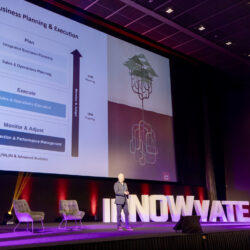Tips from S&OP vendors: ‘Embrace uncertainty, become antifragile’

The future is uncertain, and decisions may turn out differently than expected. As a company, how much risk are you willing to take in your Sales & Operations Planning (S&OP)? How do you make adjustments when things are disappointing? Some companies thrive on uncertainty, so what is their secret? At Supply Chain Media’s S&OP Flavour Day on 21 November, software vendors and consulting firms shared their best tips for making S&OP a success.
By Harm Beerens
Disruptions, scarcity, cost inflation, sustainability… these are the big challenges facing companies, and a Sales & Operations Planning process can help to address them. Christopher Lindner of software vendor Remira begins his presentation with the five well-known steps that make up S&OP: product review, demand planning, supply chain, pre-S&OP meeting, and executive meeting. ‘A planning process in which you align all departments. That sounds pretty simple in itself, but it is anything but.’ During S&OP Flavour Day, Lindner and his fellow software vendors provide recommendations aimed at simplifying the most complex parts of S&OP.
‘One of the biggest challenges in S&OP is collecting the data,’ states Will Laurence of software vendor Pigment. ‘This is so time-consuming for many companies that they cannot possibly react quickly when a new disruption occurs.’ His tip is to no longer store planning data in Excel sheets, but to use one central planning platform for this – a platform in which you also automatically integrate the forecast data from your major customers. Because if you have to request this data every time and put it in separate spreadsheets, you are constantly running behind, according to him. ‘It takes more than a month to make one plan, let alone that you have time for scenario planning.’
Risk in focus
S&OP is about making decisions, for example about how much capacity to reserve or how many raw materials to buy. ‘How demand is going to develop you never know for sure, so there is always a risk of making or buying too little. You need to have those risks in focus,’ says Icron’s Shaun Joughin. You make a forecast, determine your service levels and make a production plan. ‘Such a plan might aim to set the utilization rate of your capital goods as high as possible. This ensures lower production costs, but also makes you vulnerable. If demand is suddenly higher than expected, you won’t be able to scale up. If you want to take that risk, fine, but let it be a conscious choice.’
Joughin advises companies to prepare a good risk profile for themselves before starting to plan. ‘You have lots of types of risks and it also depends a lot on who you ask. A sales department sees very different risks than a purchasing department or Finance. You have to weigh all that up.’ Once you have your risk profile ready, the S&OP software – if all goes well – takes it into account in the planning. In fact, in Icron’s software, the risks are explicitly visualized so that everyone can see when and where in the supply chain extra attention is needed.
Defining planning levels
 Based on the five steps of the S&OP process, you go through a monthly planning cycle in which you look 12 to 18 months ahead and align your supply chain with your financial goals. ‘We also call this Integrated Business Planning (IBP),’ says Hans van der Drift of consultancy firm Involvation. He refers to an IBP project at Jacobs Douwe Egberts (JDE). ‘What you often see, and what was also the case at JDE, is that too much attention is paid to the short term during IBP meetings. There is always something acute going on, whereas IBP should be about value-based thinking. In other words, how can you create the most value in the long term? All being well, you have already determined what will happen in the next three months.’
Based on the five steps of the S&OP process, you go through a monthly planning cycle in which you look 12 to 18 months ahead and align your supply chain with your financial goals. ‘We also call this Integrated Business Planning (IBP),’ says Hans van der Drift of consultancy firm Involvation. He refers to an IBP project at Jacobs Douwe Egberts (JDE). ‘What you often see, and what was also the case at JDE, is that too much attention is paid to the short term during IBP meetings. There is always something acute going on, whereas IBP should be about value-based thinking. In other words, how can you create the most value in the long term? All being well, you have already determined what will happen in the next three months.’
Van der Drift advocates that, in addition to an S&OP or IBP process, the operational planning process should always be well established. ‘This planning layer is called Sales & Operations Execution. Which SKUs are you going to sell in the coming months, where should you hold them in stock, how much are you going to produce? You have to have this process well organized if you want to have your hands free within IBP to focus on tactical-strategic decisions.’ At coffee maker JDE, that IBP process is now tightly defined, allowing the company to better anticipate long-term developments and get a better grip on its profitability.
Power of AI
The message of Glen Campbell from Oracle is that you should, above all, harness the power of AI during a S&OP process. For example, to increase the reliability of your forecasting. In his experience, companies that do this can get by with as much as 15 to 20% less stock. Another trigger to introduce S&OP is the CSRD. ‘Companies have to reduce their carbon footprint. 88% of it is caused in Scope 3. Within an S&OP process, you have to manage this.’ He points out that while AI can do a lot, it has a downside at the same time. Using AI requires computing power, and building data centres also involves CO2 emissions. ‘These are all dilemmas for which you have to find the right balance in an S&OP.’
Increasing the adoption rates
 Jack Cheesbrough of I-Plan touches on another aspect of S&OP: adoptability. ‘There are great S&OP tools on the market, but research shows that planners only use 40% of them.’ According to him, software vendors should pay more attention to this, instead of constantly developing new functionality. ‘Everyone is talking about AI now. My tip would be to look at how to use AI to improve the adoption rate of software. For example, by applying prescriptive analytics or using smart chatbots to make the software user’s life easier.’ Within I-Plan, this is currently being fully deployed, he indicates, including an advanced help function, a step-by-step implementation methodology and a training toolkit for users.
Jack Cheesbrough of I-Plan touches on another aspect of S&OP: adoptability. ‘There are great S&OP tools on the market, but research shows that planners only use 40% of them.’ According to him, software vendors should pay more attention to this, instead of constantly developing new functionality. ‘Everyone is talking about AI now. My tip would be to look at how to use AI to improve the adoption rate of software. For example, by applying prescriptive analytics or using smart chatbots to make the software user’s life easier.’ Within I-Plan, this is currently being fully deployed, he indicates, including an advanced help function, a step-by-step implementation methodology and a training toolkit for users.
Automatically collecting data, consciously weighing risks, defining planning levels, smartly deploying AI and boosting adoption rates… these are all pieces of advice that S&OP Flavour Day attendees can take advantage of to address the big challenges of our time. In this respect, resilience has long been the ultimate goal of every supply chain director. But according to Sandeep Walia (main photo) of Slimstock, to become truly successful companies need to go one step further; they need to become antifragile.
Benefiting from chaos
Antifragile means being able to not only react quickly to change, but also to benefit from it. ‘An antifragile system thrives precisely on chaos, disruptions and change,’ Walia states. ‘Compare it to your immune system. The more viruses it has to deal with, the stronger you become.’ Examples of antifragile supply chains, he says, can be found in the fashion industry. ‘Because of disruptions and sustainability, fashion companies have moved some of their manufacturing operations from India and Pakistan to countries like Turkey, Morocco and Portugal. This means they now have more choice in their sourcing and can move faster when new disruptions occur.’
You don’t become anti-fragile overnight. To get there, your supply chain organization needs to have a long list of capabilities, Walia explains. He mentions things like digital twins, regional hubs and redundant inventories. ‘Basically, it comes down to three factors,’ he summarizes. ‘First, you embrace uncertainty and understand the impact of it on your supply chain. Secondly, you need to be agile, so that your supply chain can actually change if necessary. The third point is responsiveness. In other words, are you able to respond quickly and initiate that change in time?’
Companies face major challenges. With a good S&OP process that pays attention to risk management, and with systems that are adopted by users, companies can respond to them swiftly and effectively. If you succeed in becoming antifragile, you will make a virtue out of necessity and become ever stronger.
Want to know more? Download the Best of S&OP Flavour Day 2024 – November 20, 2024










